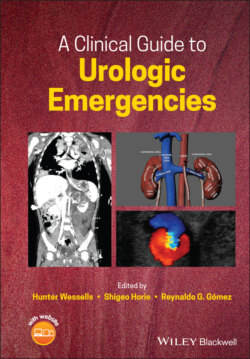Читать книгу A Clinical Guide to Urologic Emergencies - Группа авторов - Страница 24
Operative Technique
ОглавлениеAbsolute criteria for renal exploration include life‐threatening hemorrhage with hemodynamic instability, renal pedicle avulsion, and expanding, pulsatile, or uncontained retroperitoneal hematoma [25]. Renal exploration and repair in the acute injury setting is accomplished through a midline abdominal incision. While prior literature supported early vascular control, more recent literature is inconclusive on this approach [73-77]. Surgical exploration often results in nephrectomy [4]. The renal vessels can be isolated before Gerota's fascia is opened in order be able to rapidly occlude hilar vessels if significant bleeding is encountered; some advocate that this technique may lead to a lower rate of nephrectomy, whereas other data have shown no difference in nephrectomy rate, transfusion requirements, or blood loss with potential for increased operative time [76, 77]. If early vascular control is desired, an incision can be made in the mesentery medial to the inferior mesenteric vein and extended to the ligament of Treitz in order to expose the aorta [78] (Figure 1.4). The left renal vein will be visualized first as it passes anterior to the aorta and the renal arteries can then be identified posterior to the left renal vein, and the right renal vein will be identified anterior to the right renal artery. Once the hilar vessels have been isolated, the colon can then be reflected medially by incising the peritoneum lateral to the colon and exposing Gerota's fascia. The kidney can then be fully exposed in order to identify any injuries. The other approach to the renal hilum involves initial reflection of the colon and its mesentery, keeping out of Gerota's fascia, followed by isolation of the renal hilum for early vascular control, and renorrhaphy, partial nephrectomy, or nephrectomy.
Figure 1.4 Surgical approach to renal vessels and hilum. (a) Relationship between the aorta, posterior peritoneum, and inferior mesenteric vein. (b) Window in posterior peritoneum made between aorta and inferior mesenteric vein demonstrating each renal artery and vein. (c) After vascular exposure and isolation, exploration of Gerota fascia obtained by incising the peritoneum lateral to the descending colon (for a left‐sided injury).
Source: from Campbell‐Walsh, 10th Edition, with permission [39].
Repair of the kidney depends on the injuries present, and should involve debridement of nonviable tissue, suture ligation of individual bleeding vessels to obtain hemostasis, watertight closure of any collecting system defects, and closure or re‐approximation of the parenchymal defect when possible. If parenchymal closure is difficult, techniques such as thrombin‐soaked Gelfoam bolsters or omental interposition or pedicle flap may be helpful.
In terms of renovascular injuries, segmental arterial and venous injuries can be managed with suture ligation, realizing that ligation of segmental arteries will result in ischemia to the corresponding renal parenchyma. Repair of the main renal artery and vein should be attempted when safe with 4‐0 or 5‐0 prolene suture; however, many injuries of the main hilar vessels will result in nephrectomy (Figure 1.5).
Figure 1.5 Surgical management of vascular injuries. (a) Schematic showing injury to different portions of the renal vein. Injuries are repaired (b) or divided (c), depending on location and size.
Source: from Campbell‐Walsh, 10th Edition, with permission [39].
